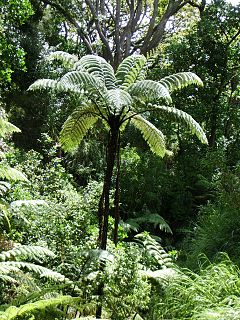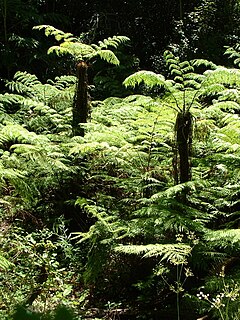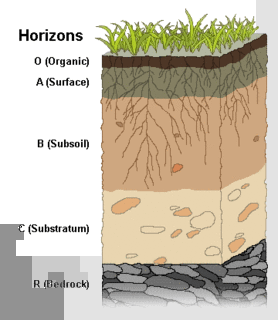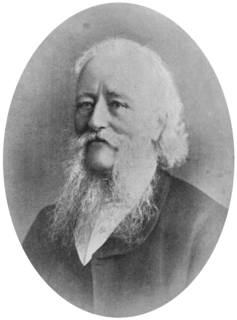
This article relates to the flora of New Zealand, especially indigenous strains. New Zealand's geographical isolation has meant the country has developed a unique variety of native flora. However, human migration has led to the importation of many other plants as well as widespread damage to the indigenous flora, especially after the advent of European colonisation, due to the combined efforts of farmers and specialised societies dedicated to importing European plants & animals.

Cyathea medullaris, commonly known as mamaku or black tree fern, is a large tree fern up to 20 m tall. It is distributed across the south-west Pacific from Fiji to Pitcairn Island. Its other Māori names include katātā, kōrau, or pītau.
Cyathea abbottii is a species of tree fern native to Hispaniola, where it grows in shaded montane forest at an altitude of 700–1200 m. The trunk is erect and can grow up to 1.6 m in height and 5 cm in diameter. Fronds may reach 1.5 m in length and are pinnate. The rachis is brown and is covered in golden-brown to bicoloured basal scales. Sori are arranged in two rows along each side of the pinnule midvein. Indusia are rounded and in the shape of a cup.
Cyathea alpicola is a species of tree fern native to central Sumatra, where it grows in montane rain forest at an altitude of 2000–2750 m. The erect trunk can reach 5 m or more in height. Fronds are bi- or tripinnate and usually 2–3 m long. They have a tendency to persist on the plant after withering, forming an irregular skirt around the trunk. This species has a spiny stipe, which is covered with a woolly layer of scales. There appear to be two forms with different scales; either dark glossy brown with a broad paler margin and fragile edges, or small, brown and finely fringed. Sori are covered by thin, fragile indusia and occur near the midvein of fertile pinnules. The closest relative of C. alpicola is thought to be Cyathea polycarpa, which differs by lacking spines altogether. Cyathea macropoda and Cyathea magnifolia may also be closely allied with this species.

Cyathea australis, also known as the Rough Tree Fern, is a species of tree fern native to southeastern Queensland, New South Wales and southern Victoria in Australia, as well as Tasmania and Norfolk Island.
Cyathea bryophila is a species of tree fern native to Puerto Rico, where it grows in the understory in wet montane and mossy forest at an altitude of 750–1200 m. The trunk is erect, up to 7 m tall and about 10 cm in diameter. Fronds are pinnate or bipinnate and grow to 2 m in length. The underside of the rachis is pubescent and has occasional scales towards the base. The scales range in colour from brown to bicoloured. Sori occur along each side of the pinnule midvein and are covered by scale-like indusia. C. bryophila is a slow growing species, reportedly only increasing in trunk height by 5 cm a year, a growth rate more akin to that of Dicksonia species. It has been estimated that plants may live in excess of 150 years.

Cyathea capensis is a regionally widespread and highly variable species of tree fern. It is indigenous to Southern Africa and South America.
Cyathea catillifera is a species of tree fern native to eastern New Guinea, where it grows in montane scrub at an altitude of about 2800 m and above. It is a rare plant, known only from the type locality. The erect trunk is up to about 1 m tall and 10 cm in diameter. Characteristically of this species, the trunk often branches at the base. Fronds are bi- or tripinnate, 1–2 m long and may bear a pair of reduced pinnae towards the base. There are usually around six live fronds per crown at any one time. The stipe is spiny, warty and pale on the upper surface to dark at the base. It is |covered with scattered basal scales that are glossy dark brown and have a paler margin. Stipes are persistent with bases retained on the trunk. Sori occur near the midvein of fertile pinnules and are covered by thin, brown indusia that are saucer-like in appearance.
Cyathea caudata is a species of tree fern native to the islands of Luzon and Mindanao in the Philippines, where it grows in montane forest. The trunk is erect and up to 4 m tall or more. Fronds are bi- or tripinnate and 1–2 m long. The stipe is warty and covered with dark, narrow, glossy scales. Sori are borne near the midvein of fertile pinnules and are protected by firm, brown indusia.
Cyathea cucullifera is a species of tree fern native to eastern New Guinea, where it grows in montane forest at an altitude of about 2400 m. The trunk is erect and 2–3 m tall. Fronds are bi- or tripinnate and 2–3 m long. Characteristically of this species, they occur in two whorls of four to six fronds each. The stipe is warty and covered with scales. The scales are dark, glossy, have a narrow paler margin and are large towards the base. Sori occur near the fertile pinnule midvein and are covered by thin, pale brown indusia that are scale-like in appearance.

Cyathea cunninghamii, also known as the gully tree fern and slender tree fern, is a species of tree fern indigenous to New Zealand including North Island, South Island and Chatham Islands; also to Victoria, possibly New South Wales, southeastern Queensland and Tasmania in Australia. It grows in damp forest, often emerging from stream gullies and riverbanks. Brownsey noted that it has a lower tolerance for drought than other species of Cyathea. The erect trunk may be 20 m tall and is usually 6–15 cm in diameter, occasionally as much as 20 cm. Fronds are tri- to tetrapinnate and 3 m or more in length. The rachis and stipe are slender, black brown, warty and covered with brown scales. Sori occur along each side of the pinnule midvein and are covered by hood-like indusia. C. cunninghamii is an uncommon and slow-growing tree fern.
Cyathea edanoi is a species of tree fern endemic to Luzon in the Philippines, where it grows in montane forest at an altitude of about 1300 m. The trunk is erect and 1–2 m tall. Fronds are bi- or tripinnate and approximately 1 m long. The stipe is covered in dark, glossy scales that have narrow, fragile edges. Sori occur near the midvein of fertile pinnules and are covered, sometimes half-covered, by large, firm, brown indusia.
Cyathea erinacea is a species of tree fern native to Mexico, Costa Rica, Panama, Venezuela, Colombia, Ecuador, Peru and Bolivia.
Cyathea hancockii is a species of tree fern native to the Ryukyu Islands, Japan, Taiwan and Hong Kong. The specific epithet hancockii commemorates William Hancock (1847-1914), who collected numerous plants in Japan, China and Southeast Asia. It grows in forest, on stream banks, and in forest margins at an elevation of about 600 m or higher.
Cyathea heterochlamydea is a little-known species of tree fern native to the islands of Luzon, Panay, Negros and Mindanao in the Philippines, where it grows in montane forest. The trunk of this plant is erect and usually up to 4 m tall or more. Fronds may be bi- or tripinnate and 1–2 m in length. The stipe is warty and/or bears short spines and scales. These scales are dark, glossy and have a narrow pale margin. Sori are borne near the fertile pinnule midvein and are protected by firm, brown indusia.
Cyathea horridula is a species of tree fern native to western New Guinea, where it grows in montane forest at an altitude of approximately 1700 m. It is a rare plant known only from the type locality. This plant has an erect trunk up to 3 m tall or more. Fronds may be bi- or tripinnate and 1–2 m in length. The stipe is covered with spines and bears scattered scales towards the base. These scales are pale and have fragile edges. Sori are borne near the fertile pinnule midvein. They are protected by small, dark brown indusia that are saucer-like in appearance.
Cyathea inquinans is a species of tree fern native to southwestern Sulawesi and possibly the Maluku Islands, where it grows in montane forest at an altitude of 2000–2800 m. This plant has an erect trunk that is usually 2–4 m tall. Fronds may be bi- or tripinnate and 1 m or more in length. The stipe is covered in scales. These scales are either large, red-brown, thin, with narrow fragile edges, or small, with a red apical seta. Sori are borne near the fertile pinnule midvein. They are protected by thin, brown indusia.
Cyathea kanehirae is a species of tree fern native to western New Guinea, where it grows in montane forest at an altitude of 1600–2700 m. The trunk of this plant is erect and 1–4 m tall. Fronds may be bi- or tripinnate and 1–2 m in length. The rachis is smooth, while the stipe is dark and warty. The stipe is covered with flat, brown, scattered scales. Sori are borne near the fertile pinnule midvein. They are protected by small indusia that are cup-like in appearance.

Cyathea smithii, commonly known as the soft tree fern or kātote, is a species of tree fern from New Zealand.
Pseudopanax colensoi is a species of evergreen plant. This species is native to New Zealand. An example occurrence in central Westland podocarp/broadleaf forests includes flora associates such as Cyathea smithii and Dicksonia squarrosa, Rumohra adiantiformis, Ascarina lucida, Pseudowintera colorata and Blechnum discolor. The maximum height of this plant is 5 meters and it is the preferred food of possums.












